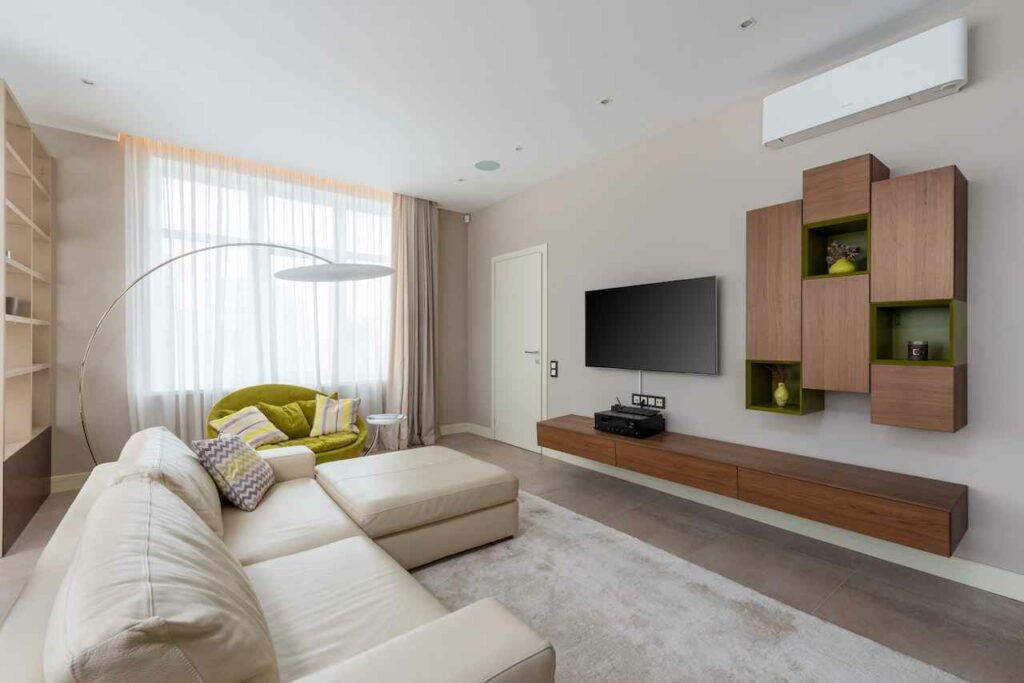To arrange living room furniture with a TV, consider the following tips:
- Define your traffic flow and pick out your main focal point
- Draw a living room layout diagram and position large furniture first
- Prioritize comfort and accessibility when placing the television so the screen faces the seating area
- Consider a horseshoe space with a TV placed against the central rib for a parallel layout
- Place the TV in the corner to make your living room set up different
- Most couches will sit around 6 to 8 feet away from the TV
What Are Some Examples Of Main Focal Points That Can Be Used When Arranging Furniture Around A TV?
Here are some examples of main focal points that can be used when arranging furniture around a TV:
- A U-shaped sectional layout that provides unrestrained visibility
- Positioning the TV facing the seating area for comfortable viewing
- Arranging furniture in a U-shape around the TV
- Choosing the right seating layout and centering it around the TV
Can You Suggest Some Software Or Tools That Can Help Draw A Living Room Layout Diagram?
Several software and tools can help draw a living room layout diagram.
Some of the best options include:
- Floorplanner
- SketchUp
- Roomstyler 3D Room Planner
- Home Design 3D
- MagicPlan
- Planner 5D
- IKEA Home Planner
- AutoCAD
These tools allow you to create a 2D or 3D layout of your living room, add furniture and decor, and visualize the space before making any changes.
They are user-friendly and offer a variety of features to help you design your ideal living room layout.
How Can You Ensure That The TV Is Easily Visible From All Seating Areas In The Room?
To ensure that the TV is easily visible from all seating areas in the room, consider the following tips:
- Determine the optimal TV size based on the distance between the TV and the seating area.
The Society of Motion Picture and Television Engineers recommends sitting at a distance where the screen fills up a minimum of 30° of your field of vision for a good experience. - Consider the viewing angle.
The minimum angle of vision works well for most usages, but people who use their TVs mostly for watching movies might benefit from sitting a bit closer to get a more theatre-like experience. - Position the TV at the right height.
The TV should be at eye level when seated. - Choose the right location for the TV.
Consider the room layout and the placement of the seating areas. - Consider mounting the TV on the wall.
This can help ensure that the TV is visible from all seating areas. - Use furniture to help position the TV.
For example, you can use a TV stand or console to elevate the TV and make it more visible.
Are There Any Downsides To Placing The TV In The Corner Of The Room?
There are both pros and cons to placing a TV in the corner of a room.
Some of the downsides include:
- Negative space left in the corner
- Potentially taking up more space than if it were mounted on a wall
However, there are also benefits to mounting a TV in the corner, such as creating an uninterrupted flow in the room and making the space feel more open.
Ultimately, the decision to place a TV in the corner of a room depends on personal preference and the layout of the space.
How Can You Incorporate Additional Seating Options In A Horseshoe Living Room Layout With A TV As The Central Focal Point?
To incorporate additional seating options in a horseshoe living room layout with a TV as the central focal point, you can consider the following options:
- A parallel layout with a pair of three-seater sofas, one placed along each wall
- A sofa set along each wall with the TV placed on the center wall
- A sectional sofa that offers flexible, comfortable seating
- Seating arranged to face both the TV and the fireplace, if present
- A sectional sofa and nearby armchair create a horseshoe shape at one end of the room







